Launched in January 2016, the White House’s Cancer Moonshot is a $1 billion initiative to jump-start the effort to eliminate cancer. A large part of this initiative is the development of cancer immunotherapies. In October 2016, Vice President Joe Biden delivered the Cancer Moonshot report that lays out the strategic plan for transforming cancer research and care.
As part of this plan, the National Cancer Institute, Amazon Web Services, and Microsoft are collaborating to build a sustainable model for maintaining cancer genomic data in the cloud. The information stored there will be available to cancer researchers through the NCI’s Genomic Data Commons and Cancer Genomics Cloud programs.
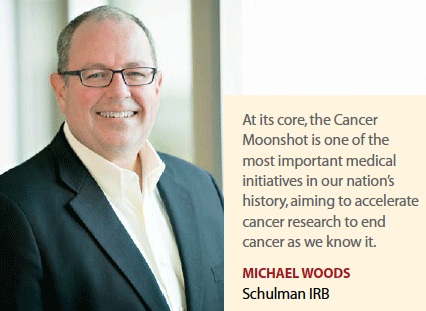 The Department of Defense (DoD) is establishing a new study to transform our understanding of the biological basis of cancer. Using the vast amount of data housed within DoD’s cancer registry database and biological sample collection, researchers will have at their fingertips potentially 250,000 samples to uncover new connections between the earliest signs of cancer. Findings can then be linked to information housed within the Environmental Protection Agency’s databases to further accelerate our understanding of the environmental factors contributing to disease progression.
The Department of Defense (DoD) is establishing a new study to transform our understanding of the biological basis of cancer. Using the vast amount of data housed within DoD’s cancer registry database and biological sample collection, researchers will have at their fingertips potentially 250,000 samples to uncover new connections between the earliest signs of cancer. Findings can then be linked to information housed within the Environmental Protection Agency’s databases to further accelerate our understanding of the environmental factors contributing to disease progression.
At its core, the Cancer Moonshot is one of the most important medical initiatives in our nation’s history, aiming to accelerate research to end cancer as we know it, says Michael Woods, president and CEO of Schulman IRB.
Schulman is the central IRB for the Cancer Moonshot 2020 program, an industry-led initiative that shares the national Cancer Moonshot program’s goals.
“With the help of this ambitious project, immunotherapies will be able to advance to the next level of research, bringing more vaccines, therapies, and, eventually, cures," Mr. Woods says. “What’s really important is the scope of the research. It involves many potential different combinations to understand how to treat individual cancers. These are not single-drug solutions but rather very complex therapeutic regimens. This requires an unprecedented level of partnership across the research community."
Our country is remarkable in its ability to innovate when properly motivated, and the Cancer Moonshot is taking a step in the right direction by creating the incentives and funding to promote the research needed to transform immunotherapy into a robust mechanism for treating cancers, says Walter Capone, board member, Carson Leslie Foundation.
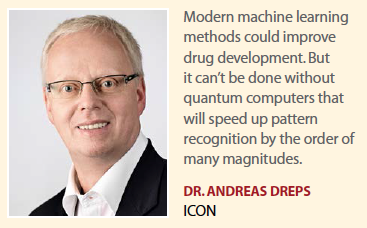 “A billion dollars is a significant amount of money, and we expect it to capture the attention of the brightest researchers and promote significant interest in immunotherapy," he says. “We hope some turn their focus toward the treatment of children in particular."
“A billion dollars is a significant amount of money, and we expect it to capture the attention of the brightest researchers and promote significant interest in immunotherapy," he says. “We hope some turn their focus toward the treatment of children in particular."
The Cancer Moonshot initiative is furthering the concept of personalized and precision medicine, which is changing the paradigm of treatment from one-to-many to one-on-one, says Etienne Drouet, VP, strategic development, SynteractHCR.
“Now we are treating patients, not just fighting disease," he says. “Emphasis is placed on the patient and his or her diversity; a disease changes from one patient to another because of an individual’s make-up. We used to treat all of the same types of cancer the same way; we were treating the cancer rather than the person. Now we have the potential to do the opposite."
In fact, the initiative has covered considerable ground since its establishment.
“From the creation of a task force to the assembly of a Blue Ribbon Panel and the ultimate agreement on 10 recommendations to accelerate progress against cancer, the initiative is building significant momentum and galvanizing all stakeholders around a common goal," says David Querry, president, Navicor Group. “A number of the panel recommendations drive directly toward advancing immunotherapeutic approaches by creating a dedicated immunotherapy clinical trial network with greater patient involvement, expanding our knowledge of cellular interactions, and mining historical tumor biology data."
The Cancer Moonshot initiative can contribute toward managing the massive datasets that are being created by genomic data, clinical data, and data from health records, says Andreas Dreps, Ph.D., senior VP, drug development services, ICON.
“Finding patterns in such massive datasets that help us understand how to fight cancer requires considerably more computing power than is currently available from classical computing," he says. “There is also broad agreement that the design of cancer trials has to be profoundly improved."
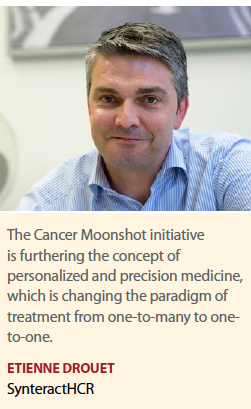 To address the challenge of analyzing huge databases, ICON is working on a concept to combine advanced statistical methods and quantum computing. Cluster trials extend the concepts of umbrella, basket, and platform trials, Dr. Dreps says. Cluster trials are made up of sub-trials involving common features such as sub-population, cancer type, genetic signature, and gain strength by sharing information between them.
To address the challenge of analyzing huge databases, ICON is working on a concept to combine advanced statistical methods and quantum computing. Cluster trials extend the concepts of umbrella, basket, and platform trials, Dr. Dreps says. Cluster trials are made up of sub-trials involving common features such as sub-population, cancer type, genetic signature, and gain strength by sharing information between them.
“The cluster trials we propose will use genomic data in combination with a plethora of other data sources, making their implementation computationally highly intensive," he says. “Quantum computers provide the computing power needed to train a machine learning algorithm to predict clinical trial outcomes from genomic and phenotypic information. Quantum computing enables us to identify patterns in data sets too large for classical analysis. Cluster designs add coherence and structure, and allow us to borrow information across sub-studies, cancer types, and patient characteristics."
Immunotherapies A Cornerstone of the Moonshot
A large part of Cancer Moonshot is the development of cancer immunotherapies. While several cancer immunotherapies are currently available, this collaborative initiative aims to accelerate the potential of immunotherapy as the next-generation standard of care for cancer.
The Moonshot initiative is giving priority to innovative cancer treatment initiatives and encouraging innovation in areas such as mining big data and exploring approaches that have not received previous priority, says David Strayer, M.D., chief scientific and medical officer for Hemispherx Biopharma.
“For Hemispherx, two of our products are being reexamined for potential important roles in this emerging area, building off the unprecedented scientific progress in cancer biology and immunology of the past decade."
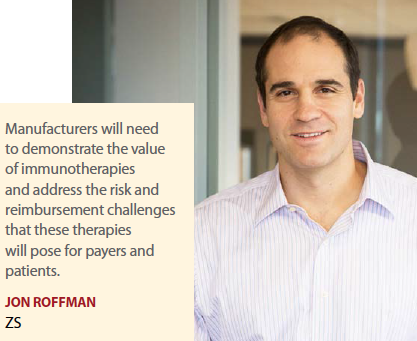 Hemispherx is developing Ampligen, an experimental RNA nucleic acid for globally important debilitating diseases and disorders of the immune system, including chronic fatigue syndrome. The company has an active NDA with the Food and Drug Administration and is in discussions with FDA to formulate a path forward for potential approval. Ampligen is in Phase II trials for colorectal cancer and in Phase I/II trials for ovarian and peritoneal cancers.
Hemispherx is developing Ampligen, an experimental RNA nucleic acid for globally important debilitating diseases and disorders of the immune system, including chronic fatigue syndrome. The company has an active NDA with the Food and Drug Administration and is in discussions with FDA to formulate a path forward for potential approval. Ampligen is in Phase II trials for colorectal cancer and in Phase I/II trials for ovarian and peritoneal cancers.
Certara CEO Edmundo Muniz, M.D., Ph.D., says the Cancer Moonshot initiative is doing an excellent job of raising awareness of new cancer therapies and encouraging stakeholder collaboration and data sharing.
“Immunotherapies have already been shown to improve objective response rates and overall survival for cancer patients when compared with the standard of care," he says. “For example, Former President Jimmy Carter was treated with the immunotherapy drug pembrolizumab for metastatic melanoma that had spread to his brain and the cancer is now in remission."
Terry Murdock, global head, oncology center of excellence, QuintilesIMS, says while immunotherapy has played an integral role in oncology research for more than a century, recently, there have been extraordinary discoveries that are transforming the industry’s approach to cancer care, dramatically improving the number of patients receiving treatment, and the duration of their survival.
“The Cancer Moonshot has brought together key public and private constituents to work together to address central challenges in cancer research to bring new options to patients more quickly," he says. “Recent advances in immunotherapies highlight new potential treatment options for patients in areas in which there have been no new therapies for many years."
The global cancer immunotherapy market is expected to reach $119.39 billion by 2021 from $61.97 billion in 2016, at a CAGR of 14.0%, according to MarketandMarkets. Factors such as increasing incidence of cancer, rising healthcare 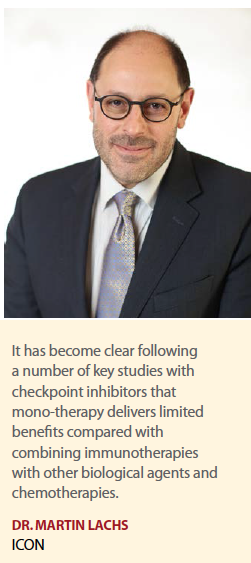 expenditures, and increased access to medical insurance in developed countries are driving growth in the cancer immunotherapy market. However, stringent regulatory policies and side effects associated with cancer therapy are the major factors restraining the growth of this market.
expenditures, and increased access to medical insurance in developed countries are driving growth in the cancer immunotherapy market. However, stringent regulatory policies and side effects associated with cancer therapy are the major factors restraining the growth of this market.
The Cancer Moonshot will provide the tools to make immunotherapies happen in at least two ways, says Wolf Gallwitz, Ph.D., chief scientific officer, Discovery USA.
“First, by providing an open-source foundational database, the National Cancer Institute (NCI) Genomic Data Commons (GDC) will combine cancer genomic and clinical data information," he says. “By facilitating data sharing the GDC will gather the information needed by the research and medical community to build a new molecular taxonomy of cancer that has clinical utility."
The second way, he says, is to have cancer patients join a new national network that will provide them with a genetic profile of their own cancer and let them “preregister" for clinical trials, so they can be contacted when a trial for which they may be eligible opens.
The Cancer Moonshot initiative is crucial to accelerating cancer immunotherapies in numerous ways, but three stand out, Mr. Capone says.
“A Moonshot approach brings significant funding to support the range of research necessary to accelerate the next generations of immune-system activating approaches to overcome cancer, from elucidating immune system biology in healthy individuals and in the context of cancer, to identifying complementary mechanisms to target all cancers effectively, to revealing how cancer originates so it can be eliminated early or prevented," he says. “The Moonshot creates broad awareness and rallies everyone with a stake in curing cancer — patients and care providers, researchers at centers and in industry, regulators and policymakers — and aligns them with a single goal."
There are a lot of immunotherapies being tested, but it is important to know that the immune state of people also changes from one person to another, Mr. Drouet points out.
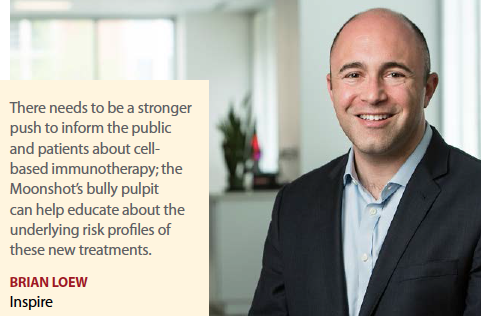 “For those not responding, we must understand why," he says. “Is the immune response blocked by the tumor? Can we introduce changes in immune pathways that could restore or enhance the response? New generations of treatments are individualized and directed in particular to those specific patients who do not initially respond or for whom the treatment rapidly fails. They still represent a large part of the patients treated. There are many different combinations that can be used to enhance the activity of the immune treatment or decrease the threshold to generate an initial immune response."
“For those not responding, we must understand why," he says. “Is the immune response blocked by the tumor? Can we introduce changes in immune pathways that could restore or enhance the response? New generations of treatments are individualized and directed in particular to those specific patients who do not initially respond or for whom the treatment rapidly fails. They still represent a large part of the patients treated. There are many different combinations that can be used to enhance the activity of the immune treatment or decrease the threshold to generate an initial immune response."
SynteractHCR is doing trials with non-responders, adding an additional treatment that may overcome the lack of response. Mr. Drouet says this requires upfront identification of the best candidates through biologic marker analysis, sequencing, and tissue biopsy.
“The role of central labs has increased dramatically," he says. “They used to be focused on post-analysis to look at correlations or differences between responsive and non-responsive patients. These makers are now starting to be used upfront, before the trial entry, to better select the best candidates for second generation treatment. Correlation between genetic profile, mutation status, and predictive activity of targeted agents have changed the way the trials are designed. In the new basket study design, the decision made on treatment choice is driven by the mutation or biomarker status of each patient rather than the specific cancer subgroup or indication. Treatments targeting a specific mutation, which have proved their efficacy in another indication, may provide a similar benefit for patients harboring the same mutation in a different kind of cancer."
Treatment Obstacles and Challenges
Immunotherapies offer tremendous hope in the fight against cancer. But there are still many hurdles to overcome and questions to be answered to drive innovation forward.
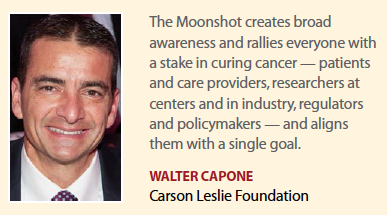 “We need to be able to leverage real-world data from experience with PD-1/PD-L1, CAR T, and other immunotherapies to predict response," says Jon Roffman, managing principal at global sales and marketing firm ZS. “For example, why do only about one-quarter of second-line non-small cell lung cancer patients respond to Keytruda or Opdivo? How do we push beyond well-known targets, such as PD1/PD-L1 and CD-19, to identify new targets for therapeutic interventions? How can the logistical challenges of CAR T-cell therapies be addressed and scaled to allow broad access to patients? How will we afford these costly therapies?"
“We need to be able to leverage real-world data from experience with PD-1/PD-L1, CAR T, and other immunotherapies to predict response," says Jon Roffman, managing principal at global sales and marketing firm ZS. “For example, why do only about one-quarter of second-line non-small cell lung cancer patients respond to Keytruda or Opdivo? How do we push beyond well-known targets, such as PD1/PD-L1 and CD-19, to identify new targets for therapeutic interventions? How can the logistical challenges of CAR T-cell therapies be addressed and scaled to allow broad access to patients? How will we afford these costly therapies?"
Mr. Roffman says the Cancer Moonshot is a welcome boost and aims to address many of these hurdles by driving collaboration and data sharing for researchers to leverage more robust information about genomic abnormalities and real-world patient outcomes.
“Tumor profiling, patient registries, and initiatives such as the Cancer Immunotherapy Trials Network can deepen researchers’ understanding of the unique characteristics of each tumor, down to the tumor microenvironment, and channel resources toward the most promising targets for immunotherapeutic intervention," he says. “Because new immunotherapies will carry a high price, manufacturers will need to demonstrate the value of these therapies and address the risk and reimbursement challenges that these therapies will pose for payers and patients. Open access to data driven by the Cancer Moonshot can reduce costs in the long term by providing a better understanding of which patients will respond, thereby opening the door to differential pricing and outcomes-based reimbursement models. In addition, lowering the data barrier to entry should increase competition further and ultimately lead to lower costs."
The challenges are the number of possible combinations and that has the potential to drive up the number of clinical trials and the time it takes to find the right combinations, says Martin Lachs, Ph.D., VP, project management, oncology and hematology, ICON.
“What has become clear following a number of key studies with checkpoint inhibitors is that mono-therapy delivers limited benefits compared with combining such immunotherapies with one another or other biological agents and chemotherapies across a number of tumor types," he says. “Additionally, the value or otherwise of treating with some checkpoint inhibitors may depend upon the level of expression of antigens such as PDL-1."
Dr. Lachs says one approach that has exploded onto the scene in the past two years is to try out a multitude of combination treatments across a multitude of tumor types.
“The permutations are vast so the complexity and competition for patient populations has risen exponentially," he says. “Of course, this creates a profoundly upward pressure on the cost to develop effective treatments, in part caused by the cost of failure, which in turn is placing greater scrutiny on the willingness of healthcare payers to meet these higher costs when held up against the relative benefits delivered."
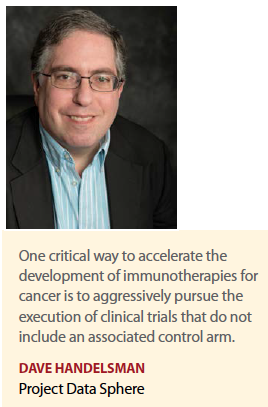 Pharma companies need the ability to effectively predict high-probability winning combinations while looking at as many possibilities in the lowest number of patients, and this requires complex statistical modeling using data from different sources to identify the most effective drugs and the winning combinations across different tumor types.
Pharma companies need the ability to effectively predict high-probability winning combinations while looking at as many possibilities in the lowest number of patients, and this requires complex statistical modeling using data from different sources to identify the most effective drugs and the winning combinations across different tumor types.
“This increases development costs," Dr. Lachs says. “The solutions? Using existing data for a basis to develop more sophisticated statistical approaches to selection of drug candidates and more elaborate if complex trial designs."
Another big challenge is knowing how to personalize care so that individuals who would benefit are distinguished from those who may incur off-target effects.
Cancer treatments have made many strides as we have gained an understanding of cancer disease etiology, and we have learned that there can be off-target effects, ranging from mild through severe, says Susan Dallabrida, Ph.D., VP of clinical science and consulting, ERT.
“Part of the dependent variable in whether there is an off-target effect has to do with the preexisting conditions of a specific patient and his or her susceptibility or resistance to the penetrance of the off-target effect," she says. “One example is the immunotherapy effect on the heart. Studies have shown that in some cases small portions of an oncology population have blood pressure issues and even heart failure. Findings revealed that individual patient factors significantly contribute to whether a patient is impacted and these impacts are not wholly predictable based on medical history."
One critical way to accelerate the development of immunotherapies for cancer is to aggressively pursue the execution of clinical trials that do not include an associated control arm, says Dave Handelsman, VP, development, Project Data Sphere.
“Many promising immunotherapy agents are designed to work with established cancer treatments," he says. “To prove the effectiveness of these agents, historical controls associated with the established treatment can be used as an alternative to an active comparator arm in the trial."
Project Data Sphere is an independent, not-for-profit initiative of the CEO Roundtable on Cancer’s Life Sciences Consortium. This repository, which contains data from 62 industry-, academic-, and government-sponsored Phase III oncology trials, has been accessed by more than 1,400 researchers and provides a resource to accelerate the development of new cancer therapies and the improvement of cancer care.
“Data-sharing initiatives, such as the Project Data Sphere repository, can enable new treatments to be brought to market more quickly and at less overall cost," Mr. Handelsman says. “By working together, the research community can build upon the success of others and ultimately bring these important therapies to patients."
The success of immunotherapy will depend on how well multiple stakeholders address several obstacles and challenge, Mr. Murdock says.
“Biopharmaceutical companies need to design the right nonclinical studies and translate the results into clinical development work," he says. “Second, we need to optimize dosing and the administration schedule of combination regimens. Third, since each drug in a combination regimen may have toxicities, we need to manage overlapping side effects."
Mr. Murdock says the regulatory science guiding development of combination regimens also needs to be refined.
Since the field of combination immunotherapy is still new, ongoing experience will allow clinicians, research scientists, and regulators to work together to determine the most expeditious pathways for new therapies to reach patients, he says.
Dr. Muniz says immunotherapies often qualify for fast-track approval, so their development timelines are condensed.
“They also tend to lack early clinical biomarkers," he says. “Thus, determining appropriate dosing from the initial clinical trial data is difficult. Regulatory agencies also expect sponsors to know what factors — age, gender, organ impairment status, etc. — might cause variability in drug exposure. In the absence of specific clinical pharmacology studies, population PK analysis can be performed on sparsely sampled PK data from patients to determine which factors significantly impact exposure and adjust dosing accordingly."
Industry thought leaders say finding biomarkers that may predict who will best respond to these immuno-oncology therapies is difficult.
Rachel Laing, Ph.D., manager, Bionest Partners, says while biomarkers have been slow to come for immunotherapy, they are likely to become more important as developers look for ways to differentiate their drugs in a crowded market.
“Identifying useful biomarkers will be challenging — especially as the pathways and mechanisms involved in different cancers and the immune response are highly complex and may change over time," she says. “Consequently, drug developers will need to collect clinical data from trials and conduct retrospective analyses to better characterize patterns of response and common features."
Collaboration is Key for Success
A major theme of the Cancer Moonshot is collaboration. There are calls for collaboration, both between institutions here in the United States and between U.S. and international research centers to share patient data, genetics, and molecular information.
“There are efforts under way to drive more patient involvement, including a clinical trials network specifically focusing on cancer immunotherapy combinations, both dual immuno-oncology combinations and combinations with targeted anticancer agents," Dr. Laing says. “There is a call to bring down research silos and encourage more collaboration between scientific disciplines, especially between immunologists and oncologists."
The Moonshot, Dr. Laing says, wants to bring together large biopharma and biotech companies, major academic cancer centers, and community oncologists together with Independence Blue Cross, one of the nation’s largest payers and Bank of America, one of the largest self-insured companies in the United States, to accelerate the potential of combination immunotherapies as the next-generation standard-of-care in patients with cancer.
“Their intent is that insurance beneficiaries and patients will undergo next-generation molecular sequencing and gain access to more than 60 novel and approved molecules to be tested as part of immunotherapy combinations in 20,000 cancer patients across all tumor types, with an aim of better informing Phase III trial designs," Dr. Laing says. “The coalition is in discussion with other major insurers to offer coverage for whole genome sequencing to continue to gather the patient data needed for this effort."
Mr. Capone says immunology, immune system and cancer biology, and systems biology are complicated enough without stakeholders impeding progress through competition.
“Thus, a pre-competitive consortium approach — like that used for semi-conductor development in the 1980s — could have a transformational impact in immunotherapy development," he says. “In addition, transferring and sharing immune system mechanism and functional knowledge from other disease areas, including but not limited to auto-immune disorders and infectious diseases, should happen more readily to enhance current and potential cancer immunotherapy development efforts."
It’s encouraging that a Moonshot-related recommendation is to connect with large federated communities of cancer patients to gather tumor samples to develop a database for genetic analysis, says Brian Loew, CEO, Inspire.
“Such databases are not only critical in elucidating key biological roles of these cancer gene variants, but they also provide a blueprint to designing better, sniper-like treatments that can be coupled with diagnostics specific to cancer molecular profiles," he says.
Mr. Loew adds there needs to be a stronger push to inform the public and patients about cell-based immunotherapy — and the Moonshot’s pulpit can help do this — and about the underlying risk profiles of new treatments.
“What’s crucial is the stated recognition that patients play an active and crucial role in medical progress, so more and better education around leading-edge treatment options, such as immuno-oncology, will help address existing major inefficiencies," Mr. Loew says. “There is a great opportunity for the Moonshot leaders to truly fuel advances by improving all facets of clinical research from patients’ points of view." (PV)
~~~~~~~~~~~~~~~~~
Cancer Moonshot Insights…
Jai Balkissoon, M.D.
 Executive Medical Director, Oncology, Global Product Development, PPD
Executive Medical Director, Oncology, Global Product Development, PPD
We are seeing more financial investments along with an unprecedented number of partnerships between small biotech and large pharma to combine their agents with the hope of increased anti-tumor activity that might lead to accelerated approval. Smaller companies are eager to develop the next exciting novel immunotherapy with the increased availability of funding and with large pharma more interested in collaborating or partnering with them. Close collaboration between CROs, pharma companies, and the FDA will play an important role in establishing platform and adaptive trials in immuno-oncology drug development.
Joe O’Connell, M.D.
 VP and Global Therapeutic Lead,
VP and Global Therapeutic Lead,
Medical Affairs, inVentiv Health
A large obstacle to developing innovative immune-oncology therapies is that some of the usual surrogate endpoints — objective response rate and median progression-free survival — that have served so well in the development of chemotherapies and targeted therapy do not seem to correlate as well with overall survival from immunotherapy. Drug developers and regulators may need to await for mature survival data to fully understand the impact of an immunotherapy.
This has clear implications for the timelines — and therefore the cost — of early stage trials. Furthermore, R&D investment decisions can be much riskier if they are made on unreliable early endpoints, and potentially efficacious drugs may be abandoned or never developed. Ultimately, better patient selection through improved understanding of predictive biomarkers may significantly address this challenge.
Mark Weinberg
 Chief Medical Officer and Managing Director, Halloran Consulting Group
Chief Medical Officer and Managing Director, Halloran Consulting Group
The biggest challenge to the future of immunotherapies is collaboration. Vice President Biden emphasized this in his Cancer Moonshot talk at ASCO where he highlighted the need for big data, academic collaboration, and worldwide sharing of discoveries as early as possible. Ultimately, the biopharma industry will need to exercise a level of collaboration that we have never seen.
~~~~~~~~~~~~~~~~~
Cancer Moonshot Blue Ribbon Panel Makes Recommendations
Dr. Douglas Lowy
National Cancer Institute
The Cancer Moonshot’s Blue Ribbon Panel (BRP) presented its report to the National Cancer Advisory Board in
September 2016. The report included 10 scientific approaches most likely to make a decade’s worth of progress against cancer in five years under the Cancer Moonshot.
“The bold but feasible cross-cutting initiatives in this report will improve outcomes for patients with cancer, prevent cancer, and increase our understanding of cancer," says National Cancer Institute (NCI) Acting Director Douglas Lowy, M.D.
The 10 transformative approaches poised for acceleration are:
Engage patients to contribute their comprehensive tumor profile data to expand knowledge about what therapies work, in whom, and in which types of cancer.
Establish a cancer immunotherapy clinical trials network devoted to discovering and evaluating immunotherapy approaches.
Identify therapeutic targets to overcome drug resistance through studies that determine the mechanisms that lead cancer cells to become resistant to previously effective treatments.
Create a national ecosystem for sharing and analyzing cancer data so that researchers, clinicians, and patients will be able to contribute data, which will facilitate efficient data analysis.
Improve our understanding of fusion oncoproteins in pediatric cancer and use new preclinical models to develop inhibitors that target them.
Accelerate the development of guidelines for routine monitoring and management of patient-reported symptoms to minimize debilitating side effects of cancer and its treatment.
Reduce cancer risk and cancer health disparities through approaches in development, testing, and broad adoption of proven prevention strategies.
Predict response to standard treatments through retrospective analysis of patient specimens.
Create dynamic 3-D maps of human tumor evolution to document the genetic lesions and cellular interactions of each tumor as it evolves from a precancerous lesion to advanced cancer.
Develop new enabling cancer technologies to characterize tumors and test therapies.
In addition to the 10 scientific approaches, the roadmap has specific, special projects. These include a demonstration project to test for Lynch syndrome, a heritable genetic condition that increases the risk of several types of cancer, to improve early detection and prevention; the establishment of a nationwide pediatric immunotherapy clinical trials
network to enhance the speed with which new immunotherapies can be tested in children; exploring patient-derived organoids; and “microdosing" devices to test drug responses in living tumors.
~~~~~~~~~~~~~~~~~
The Cost of Cancer Therapies
As the cost of treating cancer rises, patients, physicians, payers, and politicians are paying attention.
A study in the May 2016 issue of Health Affairs looked at the price of three cancer drugs at and after launch and found that there was little competitive pressure in cancer therapies. In the 2007-2013 period, per patient monthly drug prices increased 5% each year. Prices rose an additional 10% with each supplemental indication approved by the FDA and declined 2% with the FDA’s approval of a competitor drug.
Another study in JAMA Oncology found that cancer therapies approved in 2000 cost an average of $1,869 per month compared with $11,325 for those approved in 2014.
These costs need to be looked at in context, argue leaders from PhRMA. The trade group sites data that new therapies have contributed to a 23% decline in cancer deaths since 1991 and two out of three people diagnosed with cancer survive at least five years.
Pricing discussions in oncology have reached an all-time high, as treatment costs continue to increase, says Rachel Laing, Ph.D., manager, Bionest Partners.
“They are particularly relevant in immuno-oncology, where combinations of two branded drugs are likely to become standard of care in a number of indications, and innovative therapies such as CAR-Ts will command high prices," she says.
“Most experts agree that pricing will hit a ceiling at some point, although the actual threshold has not yet been determined."
Terry Murdock, global head, oncology center of excellence, QuintilesIMS, points out that pricing is more complex than might initially be thought since it is just one component of the overall treatment ecosystem. The use of combination therapy is part of the overall cost/value equation. Increasingly targeted therapies mean that there is a high likelihood that combination therapy will be required in certain cases. While providing greater patient benefits, this adds considerable cost-challenges to the development of treatment regimens.
“To find a balance between managing costs and driving innovation, hence bringing new therapies to all patients that need them, the biopharmaceutical industry must engage in discussions and work collaboratively with leaders from additional stakeholder groups, including governmental agencies, academia, payers, providers, and patients themselves," Mr. Murdock says. “Accordingly, several industry organizations, including the American Society of Clinical Oncology, the European Society for Medical Oncology, and the National Comprehensive Cancer Network have begun developing oncology value frameworks to quantify the value of various oncology drugs and therefore determine which drugs provide optimal value."
He says consideration needs to be given to rational drug pricing models that assess the value of a drug for patients, taking into account data on clinical outcomes, health-related quality of life, and cost. Such models, especially if they are data-informed, could provide a sound framework to assess the value of expensive but highly effective drugs.
Central to this topic of pricing, Dr. Laing says, is the concept of value-based pricing. Take the PD-L1 therapies as an example: Opdivo, Keytruda, and Tecentriq have been approved across six different indications, bringing different levels of efficacy across each.
“Conventional pricing wisdom applies: price-per-dose is the same across all indications for a given drug," she says. “But does this make sense? Experts have challenged this idea recently, suggesting that indication-based pricing should be considered, focusing on the value the therapy provides in a particular indication. It’s an intriguing idea, and fundamentally makes sense, but the market does not yet have the tools to calculate value. The same goes for more complex pay-for-performance schemes that may apply in the case of CAR-T therapy for example, which will require a large upfront payment given its one-dose nature. One can imagine a scheme in which only a percentage of the set price is charged up front, the remaining payment being contingent on the value it provides. This raises the question: how do you define value and over what timeframe?"
Dr. Laing says some companies are proactively starting to establish partnerships with data organizations that aim to provide information on this question of value.
Ultimately, he says this will require a significant amount of patient-level data: more than just overall survival, calculating value will also require consideration of many other parameters, such as quality of life, side-effect management, impact on indirect care costs, and many other factors.
The economics of this evolution in outcomes in cancer therapy is difficult to model, however, it should result in important savings in the net cost of patient, says David Strayer, M.D., chief scientific and medical officer for Hemispherx Biopharma.
“The potential of truly effective therapies, tailored specifically to the populations who will respond best to them, while avoiding unnecessary exposure to those who will likely not respond will result in the more selective use of these products and thus spare society from unnecessarily providing ineffective and toxic therapies," he says.
David Querry, president, Navicor Group, says using companion diagnostics to ensure the right patient is matched to the right therapy at the right time may improve the cost/benefit ratio.
“Crowdsourcing to populate the Human Protein Atlas would foster collaboration across the world; sharing tissue samples, cataloging genetic lesions, and illuminating interactions within the tumor microenvironment for cancers of all types could facilitate treatment of specific cancers in individual patients," he says.
While cancer immunotherapies will save lives, without the ability to quickly commercialize these products, patients will not receive them in a timely manner, says Curt Staab, VP, TGaS Advisors Emerging Life Sciences Network.
“Many biotech companies have focused on this area," he says. “While the clinical and regulatory hurdles can be challenging, some companies have found that commercialization of these products is much more so."
A recent TGaS Benchmark shows that biotech companies will invest as much as 17% of total revenue on sales and marketing to commercialize a specialty product such as cancer immunotherapies.
TGaS also learned that finding the right people to help with commercialization is another hurdle. The demand for commercial experience to ensure that patients get on the correct immunotherapy is demonstrated by the fact that some positions focused on commercializing cancer products have a 25% premium over primary care products, according to TGaS data.
















